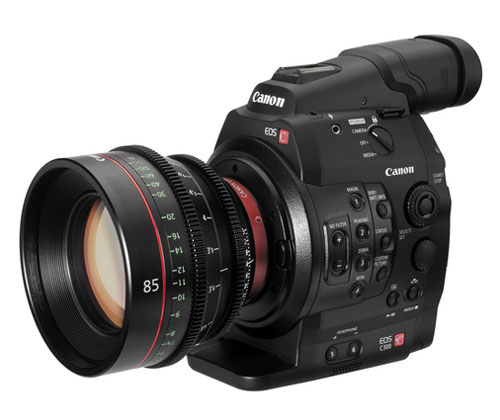A new breed of hybrid camera is threatening
to knock the DSLR off its throne
There’s no denying the impact DSLRs have
had on video production. But the days of the DSLR being the budget go-to camera
could be numbered. At the end of last year, Canon announced a new range of
cameras in the shape of the EOS C (the ‘C’ standing for ‘cinema’). The first
model, the C300, offered many features that DSLR users had been begging for,
such as built-in ND filters, professional audio support and the ability to
record clips longer than 30 minutes (a limitation provoked by trade tariffs
rather than technical issues). Canon also recently announced the C500, which
raised the bar with its support for 4K, four times the resolution of 1080p HD.

Canon
also recently announced the C500, which raised the bar with its support for 4K
Both the C300 and C500 appear to offer all
the advantages of shooting with a DSLR, but without any of the major
workarounds that are necessary. It’s easy to put up with using a DSLR for video
because it produces amazing results, but there are compromises that have to be
made. If you’re working in a controlled environment, some of these downsides
are easier to overcome, but wherever you’re shooting, there’s no denying that
it’s much more stress-free if you’re using a camcorder that’s primarily
designed to record video, rather than a stills camera for which video was a bit
of an afterthought.
The downside of these new cameras,
how-ever, is their price. The C300, for example, will set you back just under
£11,000, while the C500 has a pre-order price of £20,000. When you con-sider
you can pick up a 5D Mk II for £1,500 and the newer 5D Mk III for £2,500, even
the C300 is quite a step up.
It’s good news for videographers, then,
that Canon has decided to close the gap a little with the newly announced C100.
This camera doesn’t offer quite the same breadth of features as its bigger
siblings, but comes with a much friendlier price tag of £5,000. It’s still more
than a DSLR, but once you factor in all the extras you need to shoot video on a
DSLR – for example, an external audio recorder, HDMI monitor and some sort of
rig to hold it steady – then it’s not far off.
Sony has also been pushing its own range of
cameras that have the advantages of DSLR shooting without the downsides. The
NEX-FS100 has an asking price similar to the C100, although it doesn’t have
built-in ND filters. The more expensive NEX-FS700 does, as well as the ability
to shoot super-slow motion at up to 240fps, but it costs nearer £7,000.

Sony
has also been pushing its own range of cameras that have the advantages of DSLR
shooting without the downsides
It’s Not All
bad news for DSLRs, because those cameras will still have a place in the
filmmaking process – but it’s likely that we’ll see them move from pride of
place as the main camera in affordable setups to the role of an additional
angle, which is actually the perfect place for a DSLR.
Perhaps the biggest problem with using a
DSLR for video is the extra kit you need to bolt on to make it function like a
camcorder. External monitors, audio recorders and mounting rigs make it a
fragile and temperamental piece of kit. What you really want on a shoot is a
single unit that can do everything – just hit record and you’re ready to roll. The
more equipment you’re dealing with, the greater the risk that something will go
wrong with one of them while you’re recording, including something simply
falling off.
These hybrid models from Canon and Sony
give you the look of a DSLR but without the complexity. They have professional
XLR audio inputs and easily adjustable recording levels, so you don’t need an
external audio recorder. They’re designed to be used handheld for video, rather
than stills, so an additional support rig isn’t essential, and they have
larger, brighter screens, so you don’t need an external monitor. Furthermore,
their record time is only limited to the amount of free space you have, rather
than a preset clip size or arbitrary time limit.
Since all these extra functions are now being
handled by a dedicated camcorder, the DSLR is freed up to do what it does best
– capturing amazing video footage. The footage will also be a good match for
that taken by the hybrid cameras, so they’ll work well together. It’s
definitely not the end for DSLR video making, but the new cameras will change
its role – fundamentally for the better.